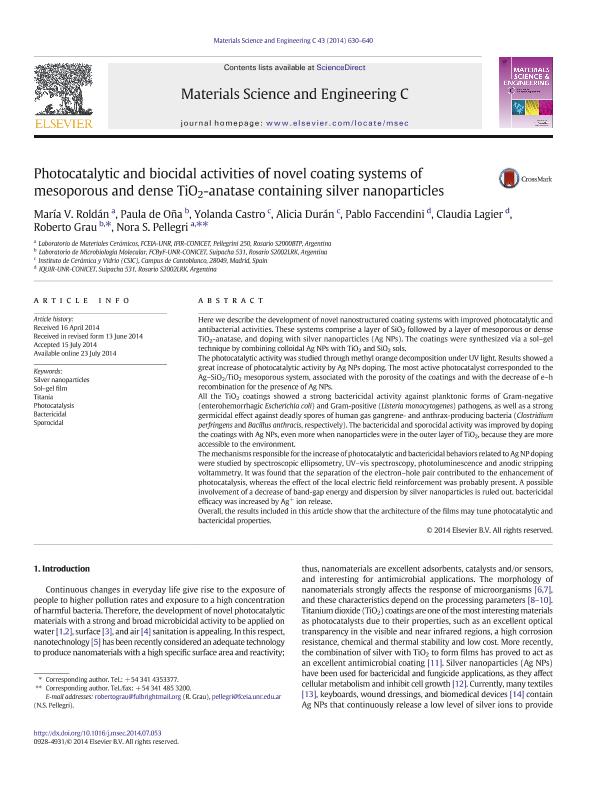Mostrar el registro sencillo del ítem
dc.contributor.author
Roldan, Maria Virginia

dc.contributor.author
de Oña, Paula

dc.contributor.author
Castro, Yolanda
dc.contributor.author
Duran, Alicia
dc.contributor.author
Faccendini, Pablo Luis

dc.contributor.author
Lagier, Claudia Marina

dc.contributor.author
Grau, Roberto Ricardo

dc.contributor.author
Pellegri, Nora Susana

dc.date.available
2016-06-09T20:59:50Z
dc.date.issued
2014-10
dc.identifier.citation
Roldan, Maria Virginia; de Oña, Paula; Castro, Yolanda; Duran, Alicia; Faccendini, Pablo Luis; et al.; Photocatalytic and biocidal activities of novel coating systems of mesoporous and dense TiO2-anatase containing silver nanoparticles; Elsevier; Materials Science & Engineering: C Biomimetic Materials, Sensors and Systems; 43; 10-2014; 630-640
dc.identifier.issn
0928-4931
dc.identifier.uri
http://hdl.handle.net/11336/6147
dc.description.abstract
Here we describe the development of novel nanostructured coating systems with improved photocatalytic and antibacterial activities. These systems comprise a layer of SiO2 followed by a layer of mesoporous or dense TiO2-anatase, and doping with silver nanoparticles (Ag NPs). The coatings were synthesized via a sol–gel technique by combining colloidal Ag NPs with TiO2 and SiO2 sols. The photocatalytic activity was studied through methyl orange decomposition under UV light. Results showed a great increase of photocatalytic activity by Ag NPs doping. The most active photocatalyst corresponded to the Ag–SiO2/TiO2 mesoporous system, associated with the porosity of the coatings and with the decrease of e–h recombination for the presence of Ag NPs. All the TiO2 coatings showed a strong bactericidal activity against planktonic forms of Gram-negative (enterohemorrhagic Escherichia coli) and Gram-positive (Listeria monocytogenes) pathogens, as well as a strong germicidal effect against deadly spores of human gas gangrene- and anthrax-producing bacteria (Clostridium perfringens and Bacillus anthracis, respectively). The bactericidal and sporocidal activity was improved by doping the coatings with Ag NPs, even more when nanoparticles were in the outer layer of TiO2, because they are more accessible to the environment. The mechanisms responsible for the increase of photocatalytic and bactericidal behaviors related to Ag NP doping were studied by spectroscopic ellipsometry, UV–vis spectroscopy, photoluminescence and anodic stripping voltammetry. It was found that the separation of the electron–hole pair contributed to the enhancement of photocatalysis, whereas the effect of the local electric field reinforcement was probably present. A possible involvement of a decrease of band-gap energy and dispersion by silver nanoparticles is ruled out. bactericidal efficacy was increased by Ag+ ion release. Overall, the results included in this article show that the architecture of the films may tune photocatalytic and bactericidal properties.
dc.format
application/pdf
dc.language.iso
eng
dc.publisher
Elsevier

dc.rights
info:eu-repo/semantics/openAccess
dc.rights.uri
https://creativecommons.org/licenses/by-nc-sa/2.5/ar/
dc.subject
Silver Nanoparticles
dc.subject
Titania
dc.subject
Photocatalysis
dc.subject
Bactericidal
dc.subject
Sol-Gel Film
dc.subject
Sporocidal
dc.subject.classification
Nano-materiales

dc.subject.classification
Nanotecnología

dc.subject.classification
INGENIERÍAS Y TECNOLOGÍAS

dc.title
Photocatalytic and biocidal activities of novel coating systems of mesoporous and dense TiO2-anatase containing silver nanoparticles
dc.type
info:eu-repo/semantics/article
dc.type
info:ar-repo/semantics/artículo
dc.type
info:eu-repo/semantics/publishedVersion
dc.date.updated
2016-06-01T13:36:40Z
dc.journal.volume
43
dc.journal.pagination
630-640
dc.journal.pais
Países Bajos

dc.journal.ciudad
Amsterdam
dc.description.fil
Fil: Roldan, Maria Virginia. Universidad Nacional de Rosario. Facultad de Cs.exactas Ingeniería y Agrimensura. No Declara. Laboratorio de Materiales Ceramicos; Argentina. Consejo Nacional de Investigaciones Científicas y Técnicas. Centro Científico Tecnológico Conicet - Rosario; Argentina
dc.description.fil
Fil: de Oña, Paula. Universidad Nacional de Rosario. Facultad de Ciencias Bioquímicas y Farmacéuticas; Argentina. Consejo Nacional de Investigaciones Científicas y Técnicas. Centro Científico Tecnológico Conicet - Rosario; Argentina
dc.description.fil
Fil: Castro, Yolanda. Instituto de Ceramica y Vidrio de Madrid; España
dc.description.fil
Fil: Duran, Alicia. Instituto de Ceramica y Vidrio de Madrid; España
dc.description.fil
Fil: Faccendini, Pablo Luis. Consejo Nacional de Investigaciones Científicas y Técnicas. Centro Científico Tecnológico Rosario. Instituto de Química Rosario; Argentina
dc.description.fil
Fil: Lagier, Claudia Marina. Consejo Nacional de Investigaciones Científicas y Técnicas. Centro Científico Tecnológico Rosario. Instituto de Química Rosario; Argentina
dc.description.fil
Fil: Grau, Roberto Ricardo. Consejo Nacional de Investigaciones Científicas y Técnicas. Centro Científico Tecnológico Conicet - Rosario; Argentina. Universidad Nacional de Rosario. Facultad de Ciencias Bioquímicas y Farmacéuticas; Argentina
dc.description.fil
Fil: Pellegri, Nora Susana. Consejo Nacional de Investigaciones Científicas y Técnicas. Centro Científico Tecnológico Conicet - Rosario; Argentina. Universidad Nacional de Rosario. Facultad de Ciencias Exactas, Ingeniería y Agrimensura; Argentina
dc.journal.title
Materials Science & Engineering: C Biomimetic Materials, Sensors and Systems

dc.relation.alternativeid
info:eu-repo/semantics/altIdentifier/url/http://www.sciencedirect.com/science/article/pii/S0928493114004615
dc.relation.alternativeid
info:eu-repo/semantics/altIdentifier/doi/http://dx.doi.org/10.1016/j.msec.2014.07.053
Archivos asociados
